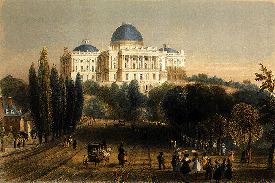The Twenty-second United States Congress was a meeting of the legislative branch of the United States federal government, consisting of the United States Senate and the United States House of Representatives. It met in Washington, D.C. from March 4, 1831 to March 4, 1833, during the third and fourth years of Andrew Jackson's presidency. The apportionment of seats in the House of Representatives was based on the Fourth Census of the United States in 1820. Both chambers had a Jacksonian majority.
December 28, 1832: Vice President John C. Calhoun resigned. The first Vice President of the United States to do so.Nullification CrisisJuly 14, 1832: Tariff of 1832, ch. 227, 4 Stat. 583March 2, 1833: Tariff of 1833 (Compromise Tariff), ch. 55, 4 Stat. 629March 2, 1833: Force Bill, ch. 57, 4 Stat. 632The count below identifies party affiliations at the beginning of the first session of this congress. Changes resulting from subsequent replacements are shown below in the "Changes in membership" section.
President: John C. Calhoun (J), resigned December 28, 1832; thereafter vacant.President pro tempore: Samuel Smith (J), first elected December 5, 1831Littleton W. Tazewell (J), elected July 9, 1832Hugh Lawson White (J), elected December 3, 1832Speaker: Andrew Stevenson (J)This list is arranged by chamber, then by state. Senators are listed in order of seniority, and Representatives are listed by district.
Skip to House of Representatives, belowSenators were elected by the state legislatures every two years, with one-third beginning new six-year terms with each Congress. Preceding the names in the list below are Senate class numbers, which indicate the cycle of their election. In this Congress, Class 1 meant their term ended with this Congress, requiring re-election in 1832; Class 2 meant their term began in the last Congress, requiring re-election in 1834; and Class 3 meant their term began in this Congress, requiring re-election in 1836.
The names of members of the House of Representatives are preceded by their district numbers.
The count below reflects changes from the beginning of the first session of this Congress.
Replacements: 7Jacksonians: no net changeAnti-Jacksonians: no net changeNullifiers: no net changeDeaths: 0Resignations: 7Interim appointments: 1Total seats with changes: 9replacements: 9Jacksonians: 1-seat net gainAnti-Jacksonians: 2-seat net lossAnti-Masonics: 1-seat net gaindeaths: 8resignations: 2contested election: 0Total seats with changes: 11Lists of committees and their party leaders.
AgricultureAudit and Control the Contingent Expenses of the SenateClaimsCommerceDistributing Public Revenue Among the States (Select)District of ColumbiaFinanceForeign RelationsFrench Spoilations (Select)Indian AffairsJudiciaryManufacturesMemorial of the Bank of the United States (Select)Mileage of Members of Congress (Select)Military AffairsMilitiaNaval AffairsOhio-Michigan Boundary (Select)PensionsPost Office and Post RoadsPrivate Land ClaimsPublic LandsRevolutionary ClaimsRoads and CanalsTariff Bill (Select)Tariff Regulation (Select)WholeAccountsAgricultureAmerican Colonization Society (Select)Asylum for the Blind (Select)Bank of the United States (Select)Biennial Register (Select)British Depredations of the Northern Frontier (Select)ClaimsCommerceDistrict of ColumbiaElectionsEstablishing an Assay Office in the Gold Region (Select)Expenditures in the Navy DepartmentExpenditures in the Post Office DepartmentExpenditures in the State DepartmentExpenditures in the Treasury DepartmentExpenditures in the War DepartmentExpenditures on Public BuildingsForeign AffairsIndian AffairsInvalid PensionsManufacturesMilitary AffairsNaval AffairsPost Office and Post RoadsPublic ExpendituresPublic LandsRevisal and Unfinished BusinessRevolutionary ClaimsRoads and CanalsRules (Select)Standards of Official ConductTerritoriesWays and MeansWholeCode of Laws for the District of ColumbiaEnrolled BillsLibrarian of Congress: John Silva MeehanChaplain: John P. Durbin (Methodist), elected December 19, 1831Charles C. Pise (Roman Catholic), elected December 11, 1832Secretary: Walter LowrieSergeant at Arms: Mountjoy BaylyChaplain: Reuben Post (Presbyterian) elected December 5, 1831William Hammett (Presbyterian), elected December 3, 1832Clerk: Matthew St. Clair ClarkeDoorkeeper: Overton Carr, elected December 5, 1831Sergeant at Arms: John O. Dunn 
